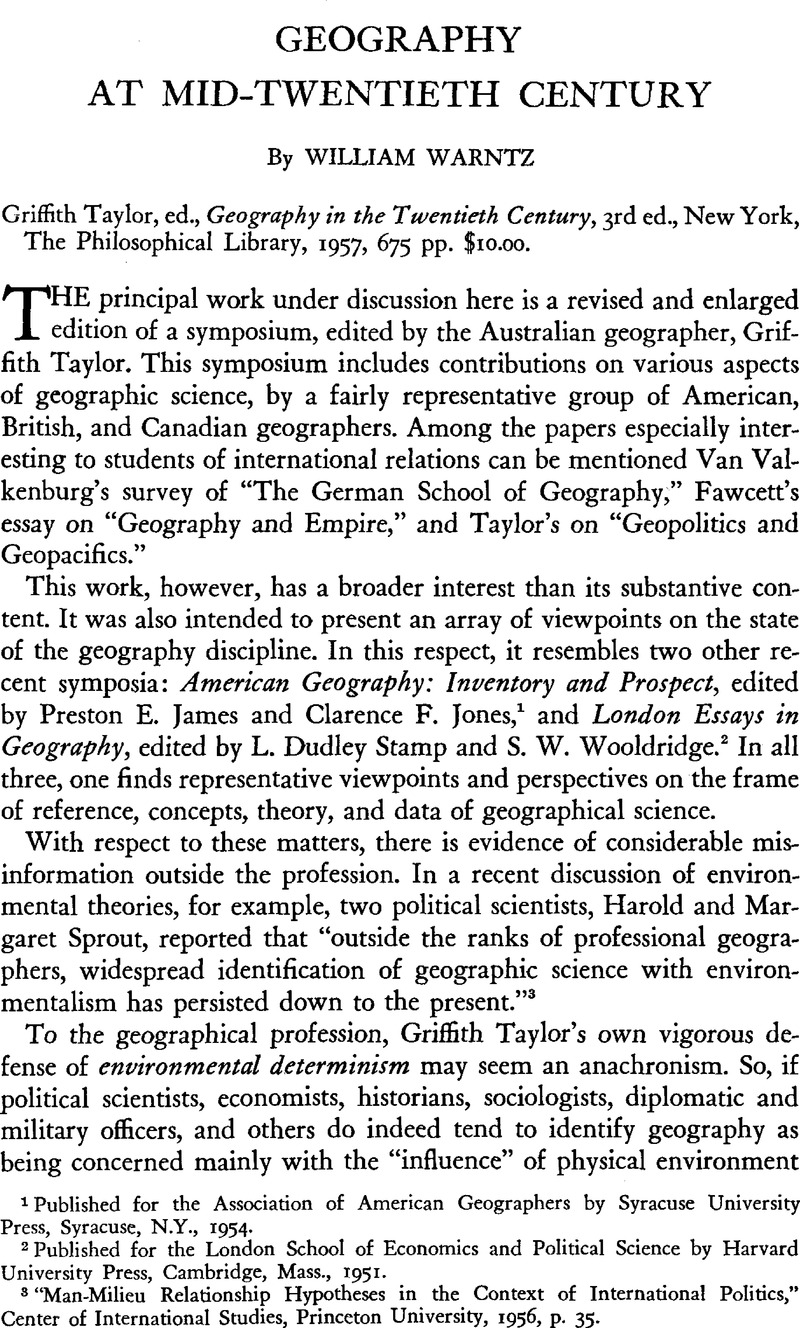Published online by Cambridge University Press: 18 July 2011

1 Published for the Association of American Geographers by Syracuse University Press, Syracuse, N.Y., 1954.
2 Published for the London School of Economics and Political Science by Harvard University Press, Cambridge, Mass., 1951.
3 “Man-Milieu Relationship Hypotheses in the Context of International Politics,” Center of International Studies, Princeton University, 1956, p. 35.
4 Taylor, Griffith, Australia, New York, [1940], p. 445.Google Scholar
5 Annals of the Association of American Geographers, XIII (1923), pp. 1–14.
6 Ibid., XLV (1955), pp. 309–18.
7 University of California Publications in Geography, 11 (1925), pp. 19–53.
8 Annals of the Association of American Geographers, XIV (1924), p. 32.
9 Op.cit., p. 315.
10 A number of recent, excellent papers in addition to those by the Sprouts attest to this remarkable upsurge in the consideration of the philosophical problems underlying the study of geographical phenomena. They include Spate, O. H. K., “The End of an Old Song? The Determinism-Possibilism Problem,” Geographical Review, Vol. XLVIII, No. 2 (1958), pp. 280–82Google Scholar; Jones, Emrys, “Cause and Effect in Human Geography,” Annals of the Association of American Geographers, XLVI, NO. 4 (1956), pp. 369–77CrossRefGoogle Scholar; Martin, A. F., “The Necessity for Determinism,” institute of British Geographers Transactions, XVII (1952), pp. 1–11Google Scholar; Montefiore, A. C. and Williams, W. M., “Determinism and Possibilism,” Geographical Studies, 11, No. 1 (1955), pp. 1–11Google Scholar; Clark, K. G. T., “Certain Under pinnings of Our Arguments in Human Geography,” Institute of British Geographers Transactions, XVI (1950), pp. 15–22.CrossRefGoogle Scholar
11 The term “probabilism” was introduced into geography by Spate, O. H. K. in “Toynbee and Huntington: A Study in Determinism,” Geographical Journal, CXVIII (1952), pp. 406–28.CrossRefGoogle Scholar
12 See, for example, Harold, and Sprout, Margaret, “Environmental Factors in the Study of International Politics,” Journal of Conflict Resolution, 1, No. 4 (1957), pp. 309–28.Google Scholar
13 This example was suggested to the author by his associate, Mr. O. M. Miller, of the staff of the American Geographical Society, New York City.
14 Stevens, S. S., “Measurement and Man,” Science, CXXVII (1958), p. 385.Google Scholar
15 Among the recent ones are Stewart, John Q. and Warntz, William, “Macrogeography and Social Science,” Geographical Review, XLVIII, NO. 2 (1958), pp. 167–84CrossRefGoogle Scholar; idem, “Physics of Population Distribution,” journal of Regional Science, 1, No. 1 (1958), pp. 99–123; and Warntz, William, “Geography of Prices and Spatial Interaction,” Papers and Proceedings of the Regional Science Association, 111 (1957), pp. 118–36.Google Scholar